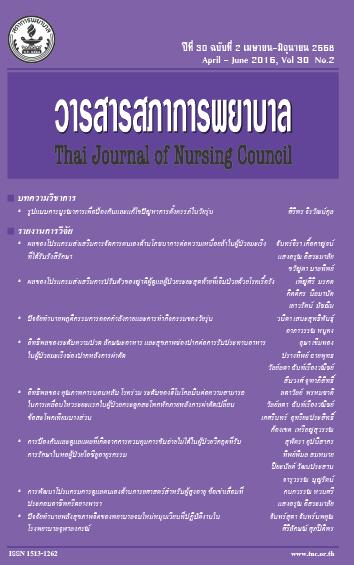อิทธิพลของ คุณภาพการนอนหลับ โรคร่วม ระดับของฮีโมโกลบิน ต่อความสามารถ ในการเคลื่อนไหวระยะแรกในผู้ป่วยกระดูกสะโพกหักภายหลัง การผ่าตัดเปลี่ยนข้อสะโพกเทียมบางส่วน
Keywords:
ambulatory ability, comorbidity, hemiarthroplasty, hemoglobin level, quality of sleep, hip fracture patients, คุณภาพการนอนหลับ, โรคร่วม, ระดับของฮีโมโกลบิน, กระดูกสะโพกหักAbstract
อิทธิพลของ คุณภาพการนอนหลับ โรคร่วม ระดับของฮีโมโกลบิน ต่อความสามารถ
ในการเคลื่อนไหวระยะแรกในผู้ป่วยกระดูกสะโพกหักภายหลัง
การผ่าตัดเปลี่ยนข้อสะโพกเทียมบางส่วน
ลดาวัลย์ พรหมชาติ พย.ม. *
วัลย์ลดา ฉันท์เรืองวณิชย์ พย.ด**
เกศรินทร์ อุทริยะประสิทธิ์ Ph.D. (NURSING)***
ก้องเขต เหรียญสุวรรณ พ.บ., ว.ว.(ศัลยศาสตร์ออร์โธปิดิกส์)****
บทคัดย่อ : วัตถุประสงค์: ศึกษาอิทธิพลของคุณภาพการนอนหลับ โรคร่วม ระดับของฮีโมโกลบินต่อความสามารถในการเคลื่อนไหวระยะแรกในผู้ป่วยกระดูกสะโพกหักภายหลังการผ่าตัดเปลี่ยนข้อสะโพกเทียมบางส่วน โดยใช้ทฤษฎีอาการไม่พึงประสงค์ (Theory of unpleasant symptoms) ของ Lenz และคณะ (1997) เป็นกรอบแนวคิดการวิจัย
การออกแบบวิจัย: วิจัยความสัมพันธ์เชิงทำนาย
การดำเนินการวิจัย: กลุ่มตัวอย่างเป็นผู้ป่วยกระดูกสะโพกหักภายหลังผ่าตัดเปลี่ยนข้อสะโพกเทียมบางส่วน 88 ราย เครื่องมือวิจัย 4 ชุด คือ 1) แบบสอบถามข้อมูลส่วนบุคคล ความเจ็บป่วยและการรักษา 2) แบบประเมินคุณภาพการนอนหลับ (PSQI) 3) แบบประเมินโรคร่วม (CCI) 4) แบบประเมินการเคลื่อนไหว (CAS) วิเคราะห์ข้อมูลด้วยสถิติถดถอยเชิงพหุ
ผลการวิจัย: กลุ่มตัวอย่างอายุ 47 – 93 ปี ( =74.3, SD = 11.2) มีโรคร่วมระดับความรุนแรงน้อย ( =2.1, SD = 1.3) คุณภาพการนอนหลับไม่ดี ( = 7.4, SD = 2.7) ระดับฮีโมโกลบินต่ำเล็กน้อย ( = 10.2, SD = 1) ความสามารถการเคลื่อนไหวไม่ดี ( = 5.2, SD = 2.7) คุณภาพการนอนหลับมีความสัมพันธ์เชิงลบ (r = -.33, p < .01) และทำนายการเคลื่อนไหวของผู้ป่วยได้อย่างมีนัยสำคัญทางสถิติ (β – .31, t = -2.93, p < .01) อย่างไรก็ตามโรคร่วมและระดับฮีโมโกลบินไม่มีความสัมพันธ์กับการเคลื่อนไหวของผู้ป่วย แต่ร่วมอธิบายความแปรปรวนของการเคลื่อนไหวของผู้ป่วยได้ร้อยละ 12 (R2 = .12, F = 3.69, p < .01)
ข้อเสนอแนะ:พยาบาลควรประเมินและส่งเสริมคุณภาพการนอนหลับของผู้ป่วย ตลอดจนพัฒนาแนวปฏิบัติการฟื้นฟูสภาพหลังผ่าตัด โดยเน้นส่งเสริมการเคลื่อนไหวหลังผ่าตัดตั้งแต่ระยะแรก
The Influence of Quality of Sleep Comorbidity and Hemoglobin Level on Initial
Ambulatory Ability in Hip Fracture Patients after Hemiarthroplasty
Ladawan Promchat M.N.S.*
Wallada Chanruangvanich D.N.S.**
Ketsarin Utriyaprasit Ph.D. (Nursing)***
Kongkhet Riansuwan M.D.****
Abstract : Objective: To investigate the influence of quality of sleep comorbidity and hemoglobin level on initial ambulatory ability in hip fracture patients after hemiarthroplasty. This study employed as the unpleasant symptom theory of Lenz et al. (1997) is used as the conceptual framework.
Design: Predictive correlation research.
Implementation: The sample group consisted of 88 hip-fracture patients, those who had received hemiarthroplasty. Four instruments which included patients’ personal and medical history treatment data, the Cumulated Ambulation Score, Charlson Comorbidities Index, and The Pittsburgh Sleep Quality Index were used to collect data. Analysis was conducted using descriptive statistics and multiple regression statistics.
Results: The subjects age range was 47 - 93 years old ( = 74.3, SD = 11.2). Most of the
them had underlying congenital diseases, the comorbid condition severity level was at a moderate ( = 2.1, SD = 1.3), and quality of sleep was poor ( = 7.4, SD = 2.7). The subjects suffer from mild haemoglobin levels ( = 10.2, SD = 1), and the initial ambulatory ability was poor ( = 5.2, SD = 2.7). The relationships between quality of sleep and initial ambulatory ability were significantly negative (r = -.33, p < .01). Regression analysis showed that quality of sleep was identified as a powerful factor in the prediction of initial ambulatory ability with statistical significance (β – .31, t = -2.93, p < .01). It was found that the quality of sleep, comorbidities, and hemoglobin level could be co-predict variances of initial ambulatory ability in the equation model by 12% (R2 = .12, p < .01).
Recommendations : It is suggested that nurses should assess and promote quality of sleep for patients with a hip fracture after hemiarthroplasty and develop nursing guidelines for post-operative functional recovery during the acute to subacute phases.








